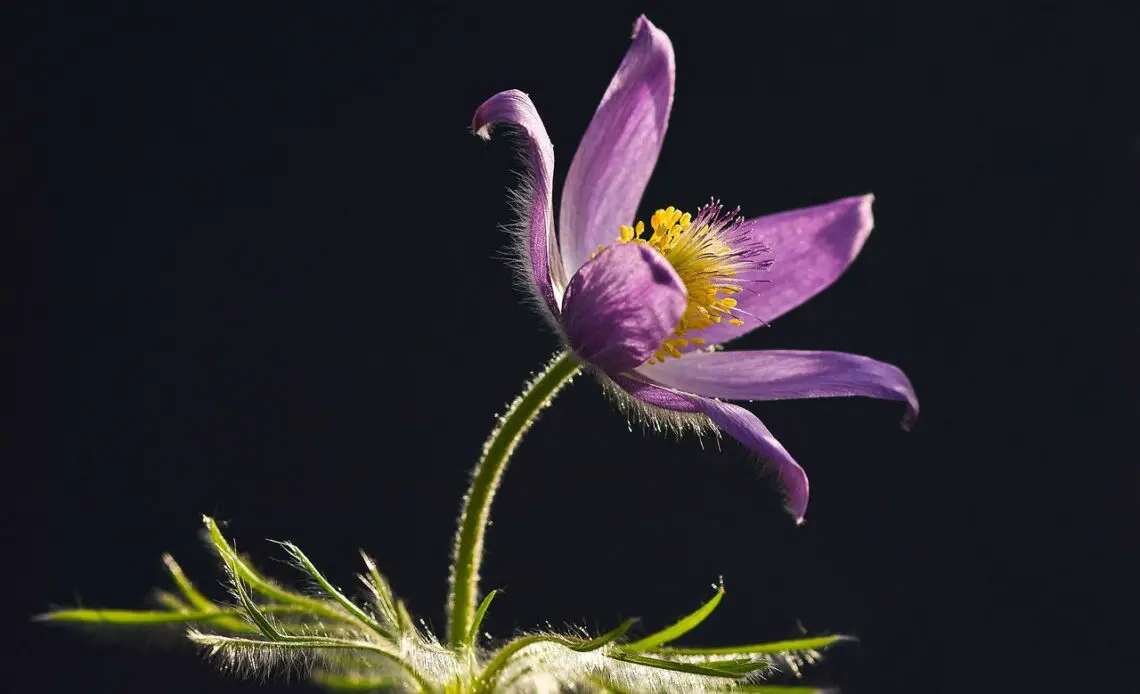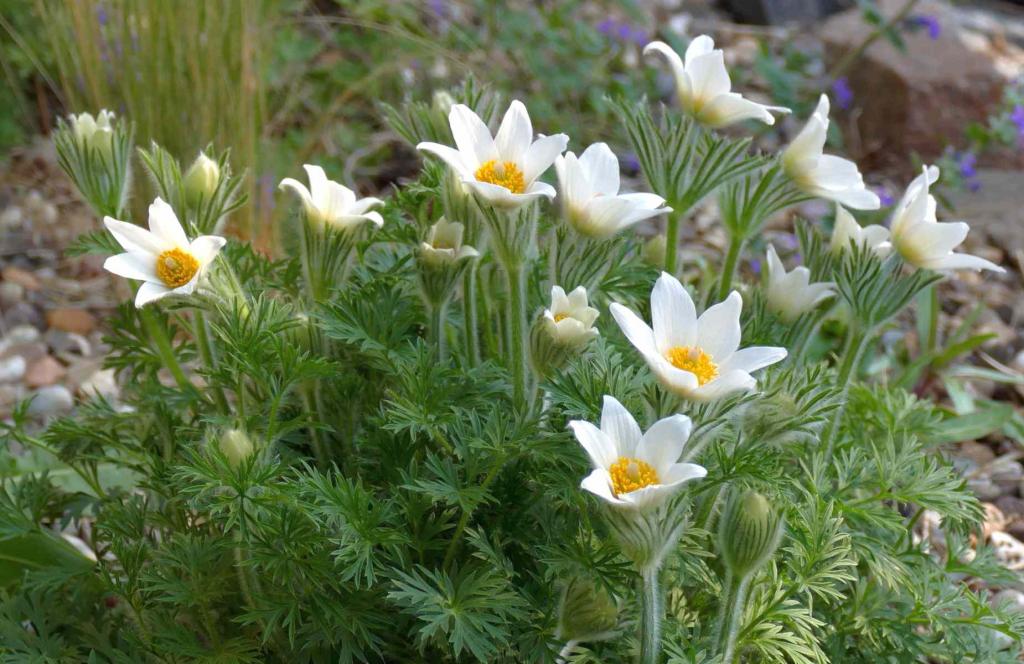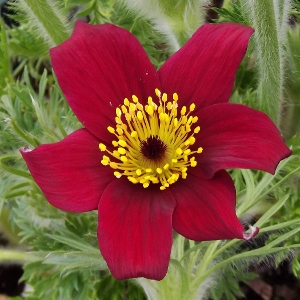
Last updated on May 21st, 2023 at 11:07 pm
Pasque flowers are beautiful and make a great attraction to gardens. They grow mostly in foothills and meadows. It is the most popular choice for gardeners since it provides vibrant color. The flowers are bell-shaped and showy with attractive seed heads. The entire plant is covered with fine and silky hairs. It has five to seven petals, like sepals with different colors.
The pasque flower is a low-growing perennial herb. It blooms in early spring. The most common pasque are bluish-purple, white, and yellow.
The word pasque flower is derived from “paschal,” meaning “of Easter,” as it blooms around Easter time. This flower is also known as the “anemone of Passiontide.” The word “anemone” is from Greek, which means “wind.” The pasque flower is also called an Easter flower, May Day flower, windflower, Prairie crocus, and meadow anemone.
According to Plant Taxonomy, the pasque flower is classified as Pulsatilla vulgaris. Pulsatilla means “beaten,” i.e., beaten by the wind, whereas vulgaris means “common.” It is named after a French-Canadian botanist, Jean-Baptiste Pasque. It has been documented since 1704.
It is indigenous to open areas of Asia and Europe. Pasque flowers grow in a dry and cool climate in highly elevated places. So, it is very popular in the Midwest and western elevated areas. It is also native to dry meadows of northern and central continental Europe and the British Isles. The pasque flowers bloom from April to June. It is a member of the buttercup family, which is known as Ranunculaceae.
What does the Pasque flower symbolize?
The pasque flower is one of the most magnificent flowers of spring. It welcomes prosperity after a long cold winter, which appeals to the eyes. Pasque flower meaning and significance bring joy and happiness.
Pasque or Anemone is related to the Nymph Anemone of Greek mythology, the beloved mistress of the God of the west wind, Zephyr. Anemone turned into a little windflower due to the rage of jealousy of Zephyr’s wife, Goddess Flora. So, the pasque flower symbolizes all that is forsaken in love.
In Christian mythology, the pasque flower is related to ideas of rebirth, nobility, grace, and dignity. It represents the Easter holiday, and pigmentation is used to color the Easter eggs.
The pasque flower symbolizes the early spring. It is a very beautiful and upward bell-shaped flower. It has deep purple petals with bright yellow stamens filled at the center. It is covered with long silky hairs and feathery grey-green leaves.
All in all, the pasque flower symbolic meanings are:
- rebirth
- renewal
- hope
- dignity
- nobility
- grace
- forsaken in love
Meaning of the Pasque flower colors
White color

White is a positive color and represents purity. White Pasque flowers are an all-time favorite, often found in early spring. It remains attractive until the end of late summer.
Purple color

Purple represents bravery, spirituality, and wisdom. These flowers will bloom from May to July in a purple color. It is commonly found in sandy and forb-grass steppes, mountain steppe, sandy and stony slopes, dry forest fringes, pine forests, and waterside pebbles.
Yellow color

Yellow represents warmth, happiness, and sunshine. These flowers begin to bloom from May to July. It is grown in shrubberies, larch and birch forests, meadows, dwarf thickets, Kobresia meadows, forest fringes, more rarely steppe slopes, pine forests, and river valleys.
Red color

These pasque flowers have bright red blooms, golden stamens, and feathery seed heads. As red flowers mean love, passion, and romance, red pasque flowers can, too!
Interesting facts about the Pasque flowers
- The outstanding feature of this flower is that it is an early bloomer. Pasque flowers welcome the early spring after a long winter.
- The juice of the petals produces a stain often used to color Easter eggs in some European countries.
- The plant’s rootstock is thick, fibrous, and woody as age passes.
- Pasque flowers are bee-friendly and rabbit-proof.
- Pasque flowers are very adaptive to nature. The hairy stems and leaves protect it from cold weather. The thick wax coating prevents frost damage.
- Although the plant is very toxic, it is used for medicinal purposes. It is a remedy for nervous system disorders. It provides aid for dealing with anxiety due to heart palpitations, nervousness, insomnia, and weepiness when a person feels frail and vulnerable. It also has analgesic (pain relieving) and antispasmodic properties.
How to grow Pasque flowers
Pasque flowers do well in somewhat cool, dry settings, including at high elevations. This makes them popular in the dryer, cooler portions of the Midwest and throughout much of the western areas at high elevations.
- Plant the pasque in humus-rich/fertile, alkaline soil that drains extremely well.
- Place them in full sun, but they can also tolerate shade or dappled sun.
- Water the newly planted frequently for the first couple of weeks.
- Ensure you don’t overwater the plants, which may lead to root rot.
- Apply organic compost.
How to care for Pasque flowers
- Do not disturb the pasque plants once established.
- Water only during prolonged dry spells.
- Deadhead the flowers once they have wilted.
- Propagate by taking cuttings from shoot tips if you require more plants.
Best time to gift Pasque flowers
Since pasque flowers bloom in early spring, these flowers can be given as a gift from April to June. It may also bloom between March and May. It will last up to 2 weeks before dying off until the next spring season arrives.
It is an ideal companion plant for other early spring blooming bulbs like miniature daffodils, crocus, and wildflower tulips.
Conclusion
Given all of the challenges some countries face in maintaining significant populations of pasque flowers, planting and cultivating your own is a fantastic idea.
The pasque flower, with its gorgeous, deep purple blossoms and ease of care, can be an excellent addition to any garden or windowsill. Its beauty will brighten your spring season.
If you want to know and learn more about flowers, we at PansyMaiden can help you. Check out our fun, easy-to-read, and informative flower-related content that you will surely enjoy!
